Nine times out of ten when we start having a conversation with a potential prospect, one of our immediate initial quick wins involves internal linking.
If you’re reading this, most likely you’re sitting on a goldmine of internal linking opportunities for your own SaaS business that you could be leveraging to:
The problem is most SaaS marketing teams don’t leverage internal linking, which we’ve found a few common reasons for:
We look to make internal linking as simple as possible for our clients, as well as to ensure we’re executing on opportunities.
That’s why we’re able to leverage the power of our existing backlink profile to beat out much stronger competitors in the SERPs.
Ready to take action on properly building internal links – something that probably 95% of your competitors aren’t leveraging?
Let’s dive in.
Let’s start with the importance of why internal links can be a huge win for growing your organic traffic and crushing your competitors in the SERPs.
Every time another website links to our website, this is considered a vote of confidence in the eyes of Google.
In the SEO world, this is considered a backlink or external link.
By creating backlinks to our website, we’re essentially establishing authority with Google that our website deserves to rank higher and higher in the search results.
Backlinks are one of the strongest indicators to Google of which pages and websites should rank high in their search results (i.e. the top positions of Google – which we know statistically get the most clicks).
Now, knowing that backlinks have a very strong influence on our search rankings – it’s logical to derive to which pages those links point to will also signal to Google what important pages of the site should rank and be shown in the search results.
Related Content: Link Building for SaaS
Now here’s where the magic happens:
By understanding which pages have the most backlinks, we’re able to “pass” that link value to other pages of our website in order to:
Essentially, by strategically understanding how we connect our pages to each other (with links) we can pass authority and link value to certain pages to help them rank.
Here’s a great example of why internal links are extremely important:
Many B2B SaaS businesses will have the following core pages on their website:
These are known as bottom-of-the-funnel pages, where generally these are conversion pages where users land and have a higher intent of a micro conversion happening – meaning signing up for a trial, or requesting a demo.
Now, ranking these pages in Google’s search results across many verticals can be very competitive.
Outside of attempting to optimize these pages through content and other on-page edits, it’s going to require backlinks pointing to these pages in order to get them to the top of Google’s search results.
Generally, any other website is going to be much less likely to naturally link to one of these pages, compared to your homepage, or a blog post or other post which is acts as a resource.
Why?
Because naturally these are copy-focused pages that don’t provide any type of intrinsic value of linking to for other websites – but value-add, informational content and resouces do provide a reason to be linked to simply because they’re a great resource that’s being referenced or shared with that audience.
This is where internal links come into play.
By building internal links from other relevant pages that have a high quantity of backlinks, we can pass the value from those pages to our core bottom funnel and other pages, causing them to rank higher in Google’s search results.
Oftentimes, clients look towards building backlinks to solve their ranking issues, where rather first by leveraging internal links in a smart and strategic way can save a lot of time, and money.
There are two core types of internal links at play that can be leveraged when building our internal linking strategy:
Navigational links generally are included within the main structure of the website, meaning they’re accessible site-wide.
This includes normally the header navigation of the website:

As well as the footer navigation of a website:
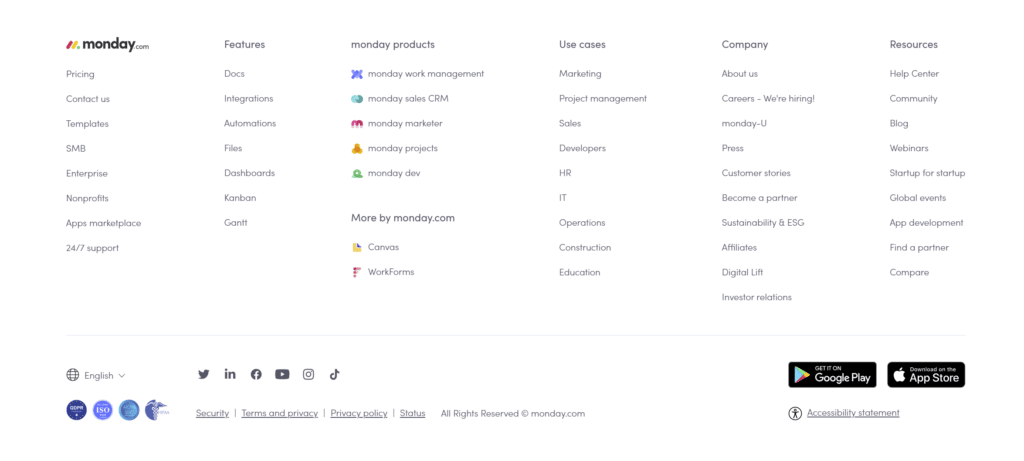
The primary purpose of navigational links is to allow users to easily find core pages of the website.
Navigational links are a very strong indicator to Google that a page is important since the link is accessible site-wide.
Generally, you’re going to want to include your core bottom-funnel pages, such as:
This will help to make these pages always accessible and found by users, by search engines, and also signal their importance to Google (as well as passing link value).
Pages that drive the most organic traffic, as well as revenue, generally will and should appear within the navigational links of the website.
Contextual links are links placed within the body of a page.
As we already know, natural backlinks generally will be gathered up by pages that are naturally a great resource such as mid and top-funnel content.
Here’s an example of a contextual link within one of Monday’s blog posts, linking to a piece of relevant content regarding the process for organizing an onboarding process:
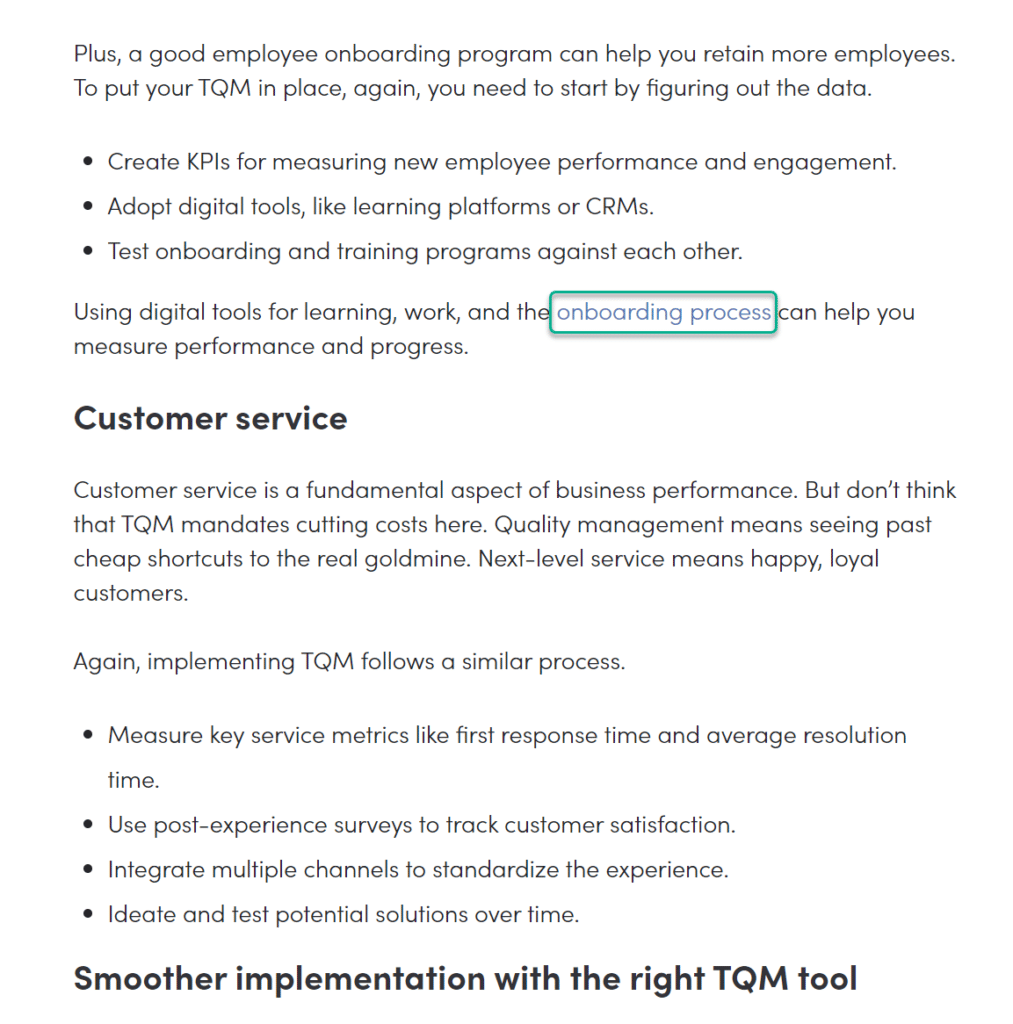
It’s important to pay attention to how easily found and clickable your contextual links are within your content.
💡 Note: The great thing about both navigational and contextual links is that you can fully control the anchor text which is being used. For backlinks that occurr naturally, the other website linking to your website controls what they choose as their anchor text. Internally, you can stratetically choose not only to which pages you link, but also the anchor text being used which also is an important factor when building an internal linking strategy.
Remember – contextual links are important from a search engine perspective, but also should be leveraged to deliver value to your users and push them to other relevant pages.
Auditing your internal links is made easy with the help of Ahrefs.
My suggestion to get started is to find your most valuable pages by backlinks, and then you can start to build a strategy around those pages to push their value to pages you want to rank, and which are relevant.
You can easily find the most powerful pages of your website using Ahrefs, and by navigating to:
Site Explorer > Enter Your Domain > Best by links
Here’s an example from Monday.com’s Best by links report:
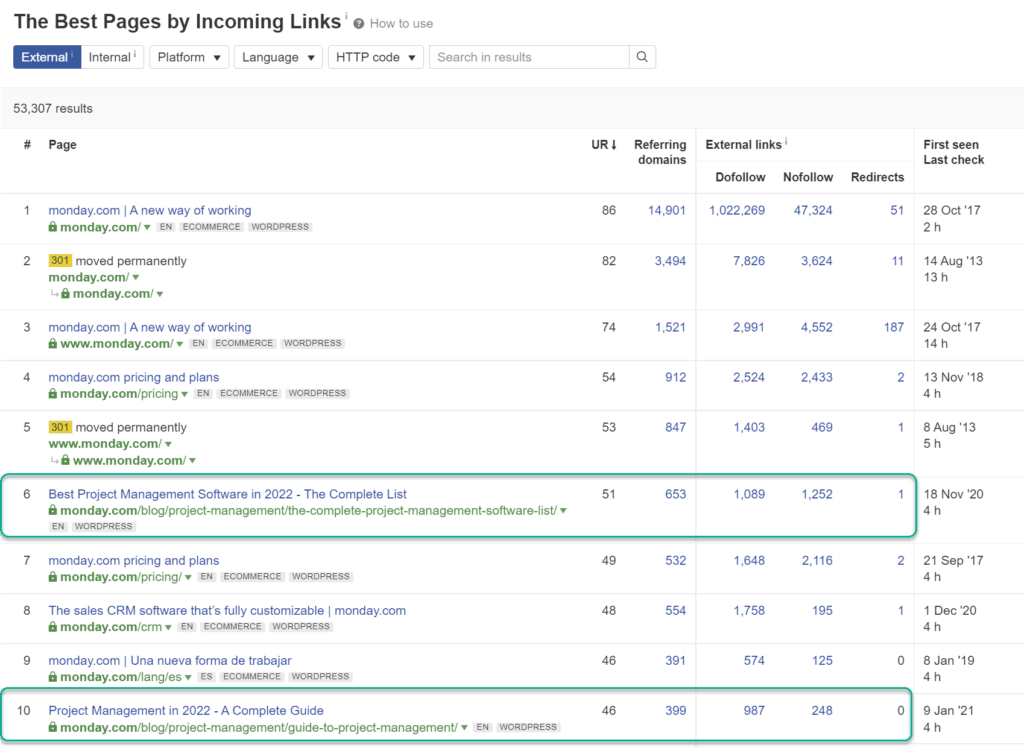
You’ll notice that within their top 10 most-linked to pages from third-party websites, that two pieces of blog content standout:
Both of these pages have a ton of quality links pointing to them, making them an excellent starting point to start building internal links to other relevant pages.
Which, that’s exactly what Monday has done using contextual links within their content:
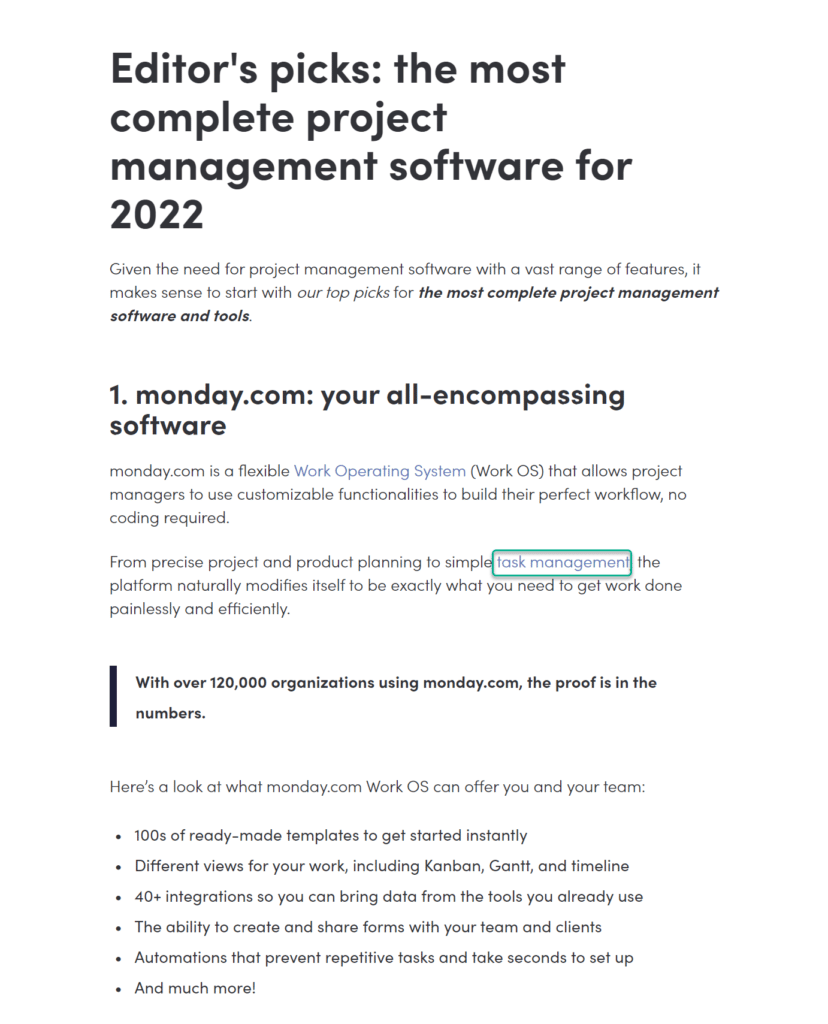
Throughout their content, they’ve built-in contextual links to bottom, mid and other top funnel pages to essentially create content silos and pass link value from these pages.
This naturally will have a strong impact on the rankings of these pages from around the time when the contextual link was added, and into the future as the linked from page continues to gain backlinks over time.
This creates a snowball effect over time.
As the pages linked to also start to rank, they’ll also naturally gain links (again, typically value-add style content) where those pages then can link to others within the silo.
This is the compounding effect of using internal links in a strategic manner.
👉 Not sure where to start with strategizing how to squeeze the most out of your backlinks and internal links? We can help you. Schedule a Free Grow Faster Session with our veteran SaaS marketing team, and we will show you step-by-step how to tackle this.
Now, you know which are the most powerful pages of your website.
But how do you find opportunities from pages to link to?
The quickest way to get a high-level picture is to run an SEMRush audit of your website, and then head over to the results page:
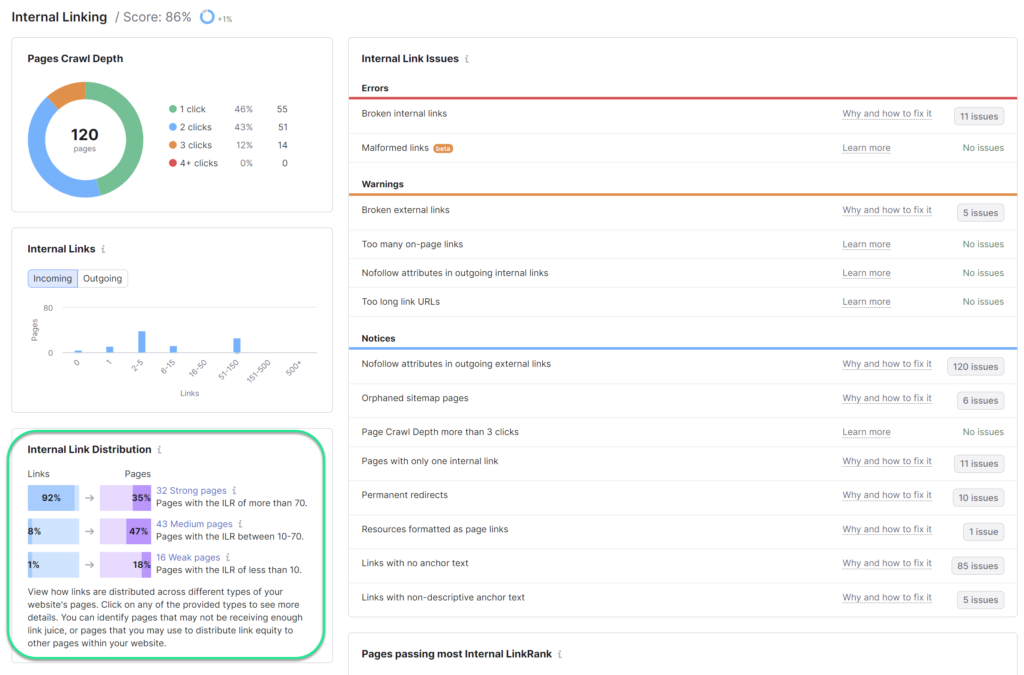
SEMRush will breakdown your pages by internal links across three core areas:
Using an internal calculation, SEMRush finds pages that have no to minimal opportunities, and that are ripe for adding internal links to:

Now you can click on the Medium and Weak pages to manually review which of these are important pages, and start to make a list of pages that you want to buff up with internal links:

Now we have a list of our best pages by links, as well as our link opportunities – let’s dive into how we can clean all of this up and start internally linking to get the link juice flowing.
Struggling to grow organic demos signups? Rock The Rankings is a top-ranked SaaS SEO Agency that helps SaaS businesses make organic their customer acquisition engine. We’ll create a free marketing plan for your business, and walk you through step-by-step exactly what needs to be done to grow faster.
Building internal links should be done in a strategic manner, with relevance top of mind.
Think of your overall website hierarchy in the form of a pyramid.
Starting at the top with the most important page, and the bottom with the least important.
At the top of the pyramid, you have the homepage.
Underneath of the homepage, you have your bottom-of-the-funnel, conversion pages – features and benefits, use cases, integrations, etc.
Then you move into slightly less important conversion pages, such as blog content, resources, etc.
You want to find a way to build internal links to these pages that makes sense for your users, drive relevance to Google, and help to pass link value.
The way to tackle internal linking in a strategic way is to build so-called “content silos”
The practice of creating content silos is grouping together topically related pages using internal links.
Imagine we’re running a B2B SaaS that’s solution is geared towards common problems around employee onboarding.
Here’s an example of a singular, simple content silo that we could create:
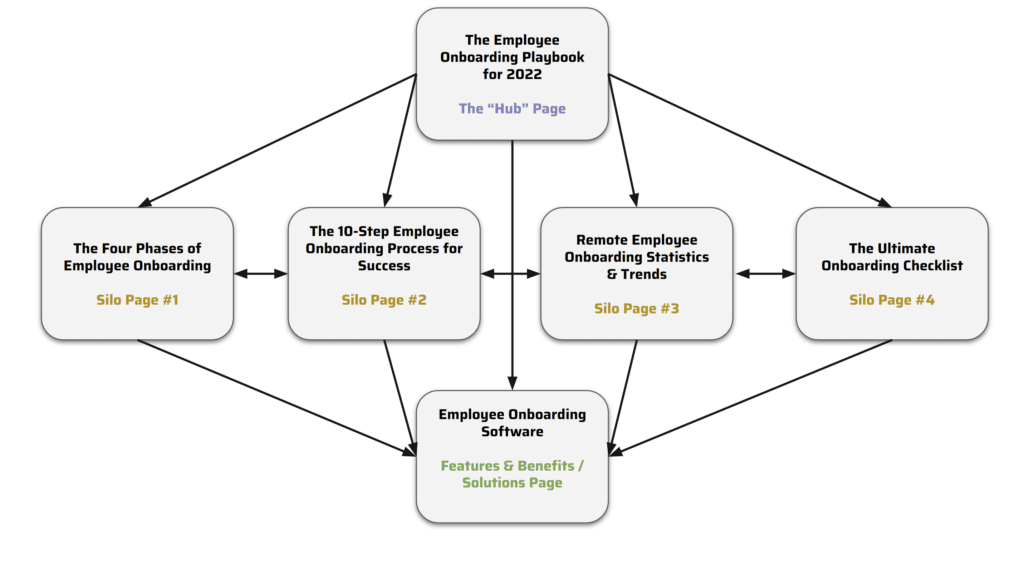
Now, let’s break this down step-by-step.
At the top of our silo, we have our “hub” page.
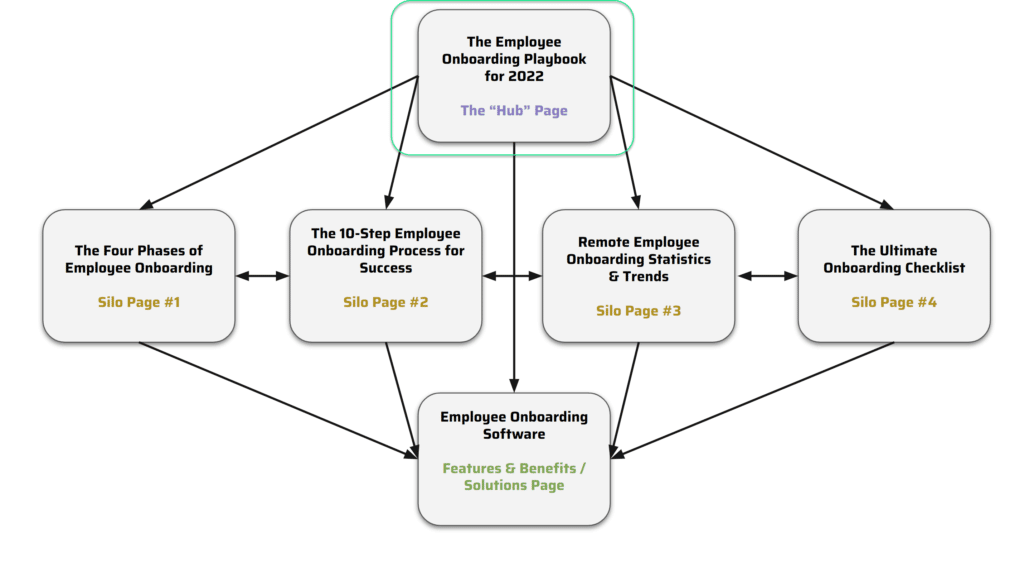
The hub page is our primary page within the content silo.
Within the hub page itself, we will have a super in-depth piece of content that goes deep into our overall topic – it this case, the topic around employee onboarding.
From our hub page, we have subpages that we call “silo pages”.
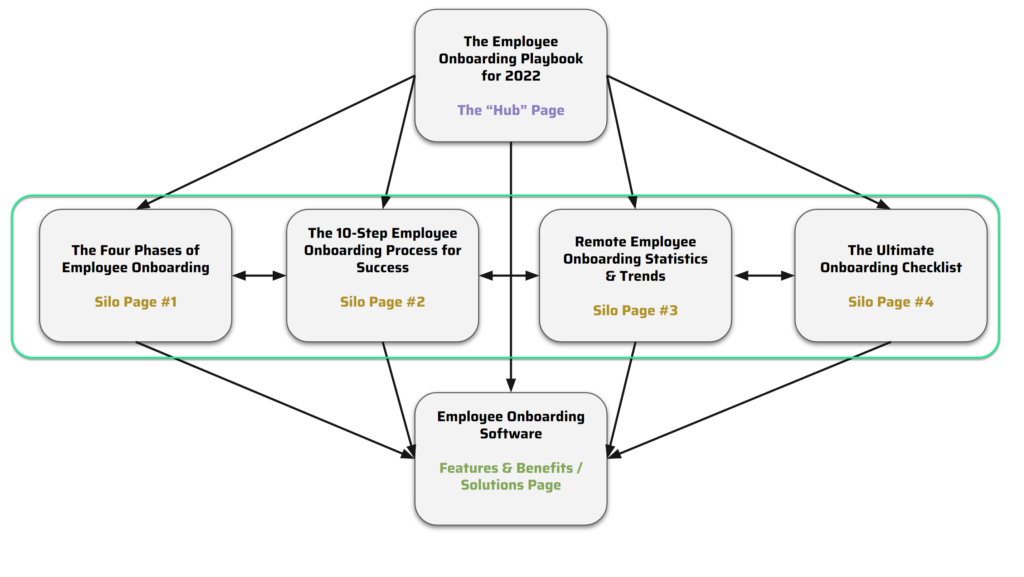
The purpose of our silo pages is to take a deeper dive into the sub-topics related to employee onbording, so as in our example above:
Notice how we link from the hub page to each of these pages, and we also link between the silo pages to other silo pages.
This is how we actively create a content silo (also known as a topic cluster).
All of these pages are related to the same topic and are relevant to one another.
The core benefits of this include:
Finally, at the bottom of our silo, we have a conversion page – in this case, our features and benefit page (or solutions page) which targets the keyword “employee onboarding software”:
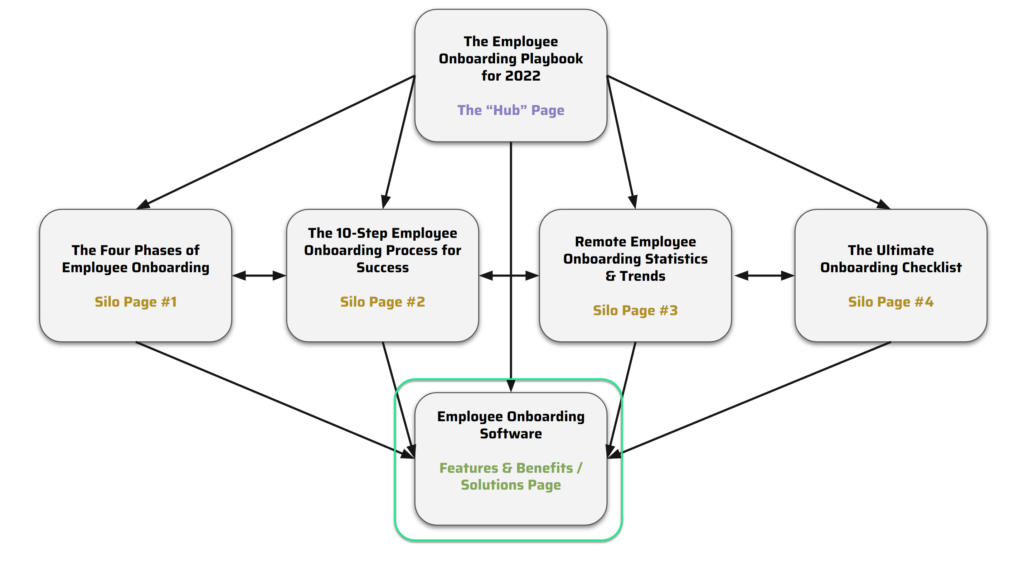
Remember earlier how we mentioned it’s unusual for our conversion pages to get backlinks?
This strategy allows us to use internal links to distribute link power to our conversion pages, as well as to gradually push users down the funnel while navigating our website.
Now, this is a high-level content silo example – where in some cases, we can have a much larger silo and have different ways of how we actually interlink our pages – but in the most simplistic form, this is how it’s created to best leverage internal links.
Internal links are an integral part you should be monitoring and strategically building within your content strategy.
Related Content: SaaS Content Strategy
When we start working with clients, we take an inventory of all of their existing pages and content using our Growth Audit, and that allows us to understand where we have content gaps, and how we can properly arrange our content into content silos to best leverage our existing backlinks:
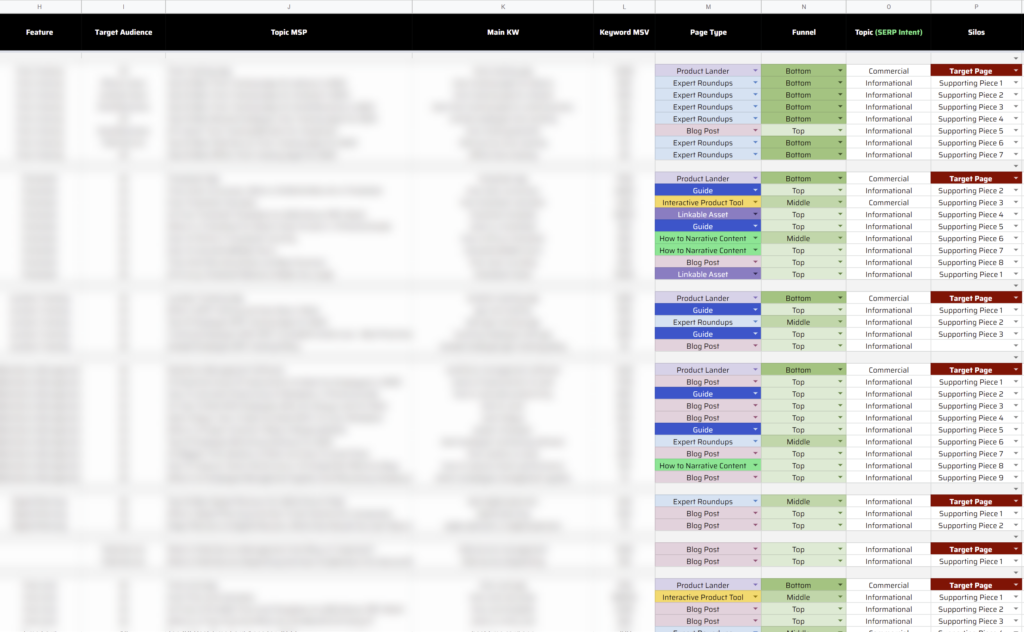
From there, it’s simply building out content silos, and best understanding how we internally link across our pages to drive search rankings and conversions:
This is also the core reason you should be building content briefs for your writers and content team to easily manage internal link insertions via contextual links:
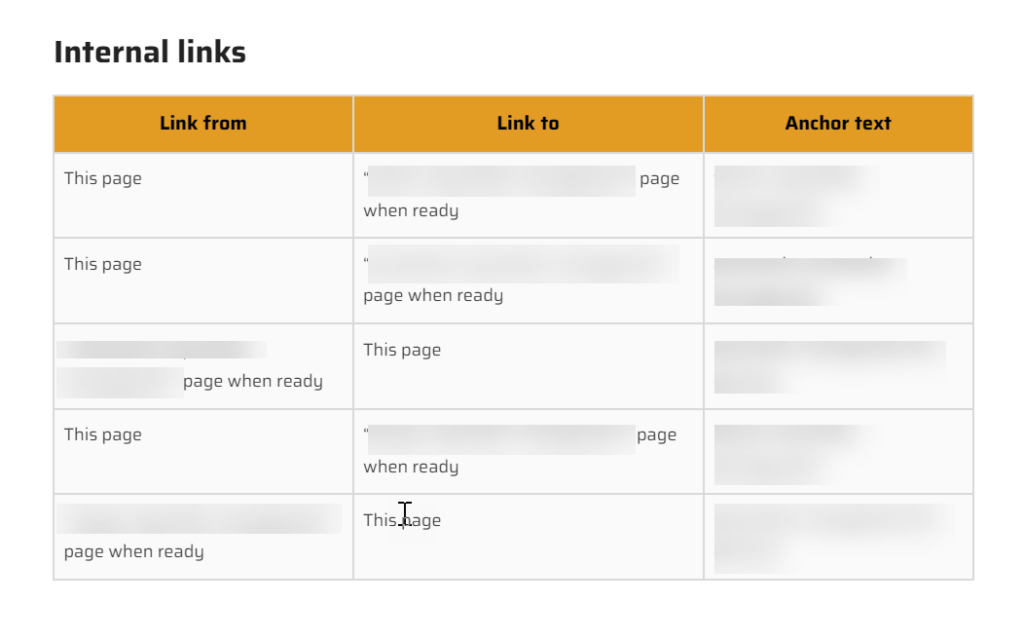
For best results, it’s great to do a quarterly link audit – especially if you’re creating content at scale.
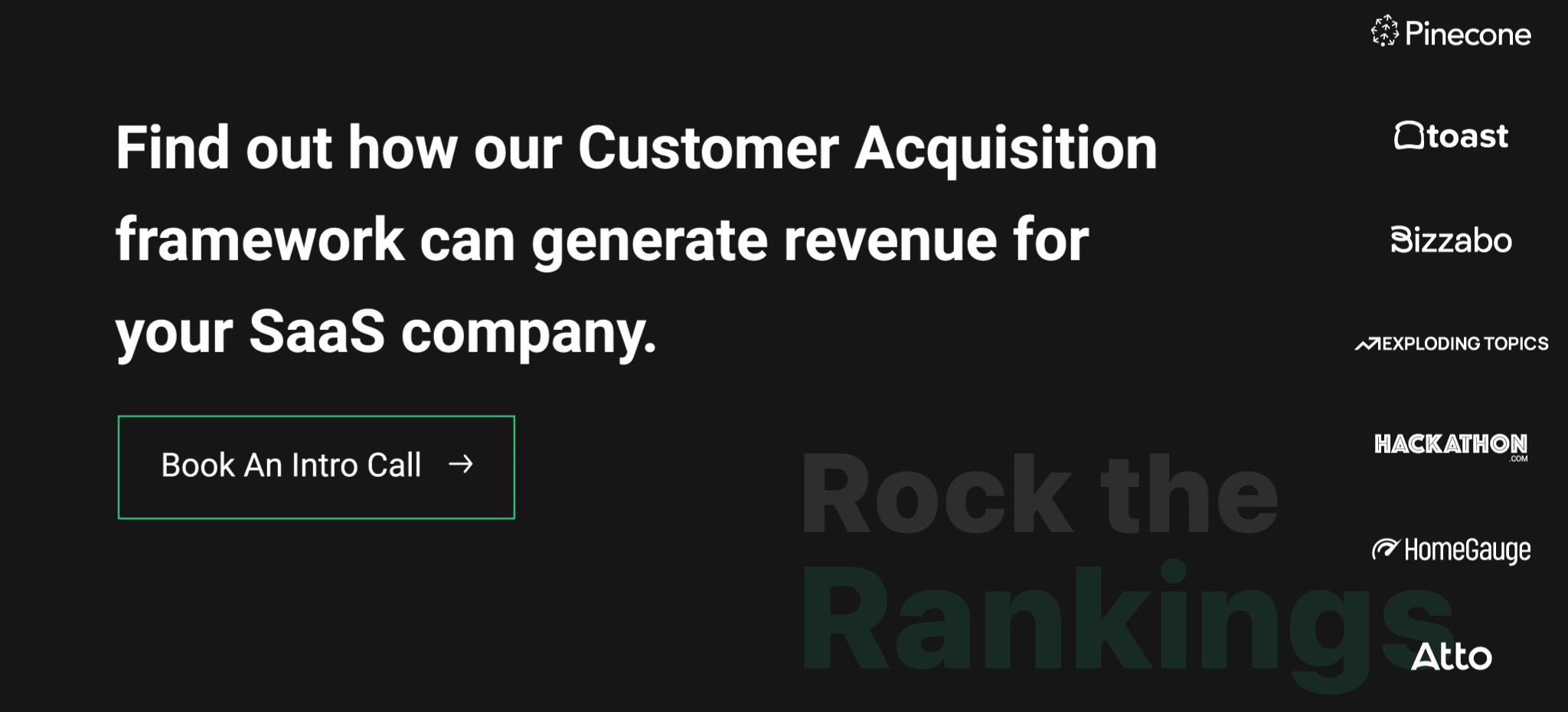
Creating an internal linking strategy will help your business rank higher on Google, and is guaranteed to be something that the majority of your competitors are not focused on.
If you take a simple approach as laid out above, and execute, you’ll see results within a short time frame – especially if you’ve never looked into building internal links strategically in the past.
Here’s what to keep in mind when building internal links:
Internal linking is one of the easiest quick wins most businesses don’t leverage – will you take advantage and start to use your existing links to dominate the competition?
Founder of Rock The Rankings, an SEO partner that helps B2B SaaS brands crush their organic growth goals. An avid fan of tennis, and growing micro-SaaS businesses on the weekend. 2x SaaS Co-Founder – Currently working to build and scale Simple Testimonial.
Book a 1-on-1 intro call with our founder that includes a FREE custom marketing plan. Start growing faster, today.